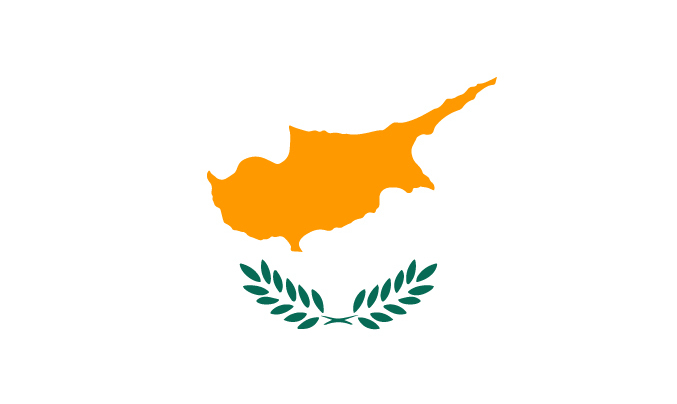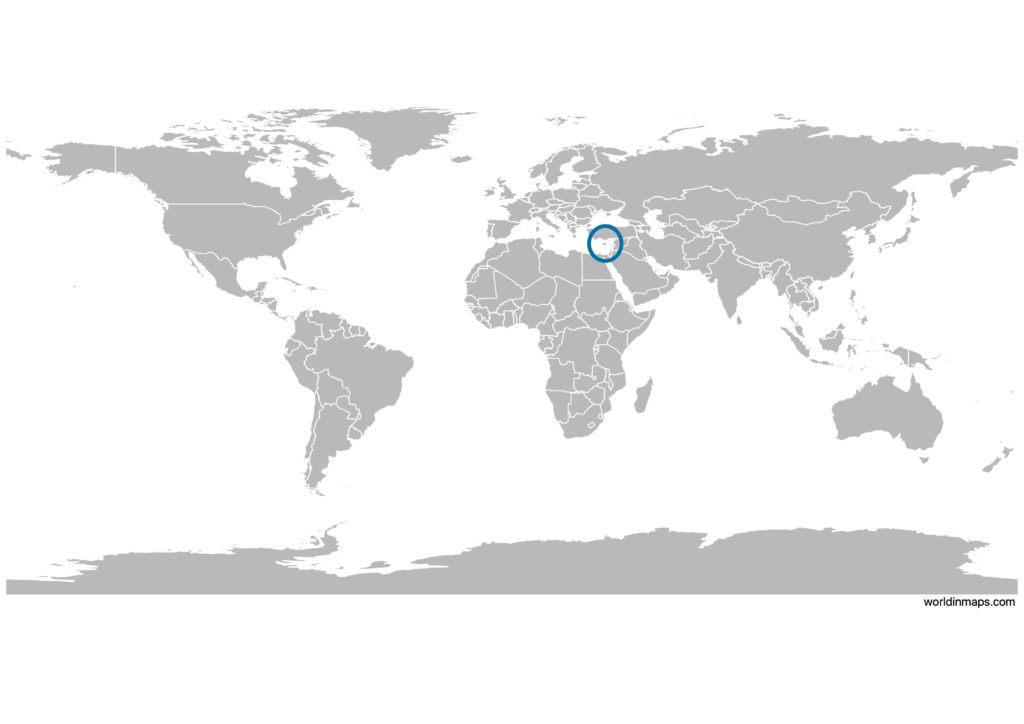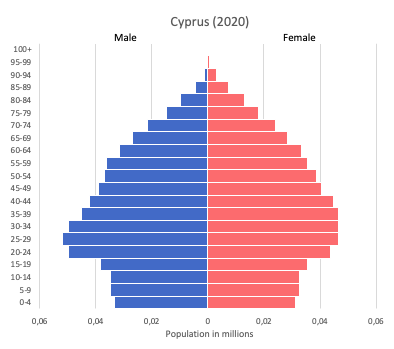Cyprus

| Government | |
| Name | Republic of Cyprus |
| Greek | Κυπριακή Δημοκρατία |
| Turkish | Kıbrıs Cumhuriyeti |
| Government type | |
| Republic of Cyprus | Presidential republic |
| Turkish Republic of Northern Cyprus (self-declared – only recognized by Turkey) | Parliamentary republic with enhanced presidency |
| Capital | Nicosia (200,452 (2011)) |
| Currency | Euro (EUR) |
| Organization | |
| Member State | Commonwealth of Nations |
| People | |
| Population (2020) | 1,207,361 (158th) |
| Density of population | 123.4 P/km2 (82nd) |
| Nationality | Cypriot |
| Official languages | |
| Greek | |
| Turkish | |
| Ethnic groups (2011) | |
| Greek | 98.8% |
| Other (includes Maronite, Armenian, Turkish-Cypriot) | 1% |
| Unspecified | 0.2% |
| Religions (2011) | |
| Orthodox Christian | 89.1% |
| Roman Catholic | 2.9% |
| Protestant/Anglican | 2% |
| Muslim | 1.8% |
| Buddhist | 1% |
| other (includes Maronite, Armenian Church, Hindu) | 1.4% |
| Unknown | 1.1% |
| None / atheist | 0.6% |
| note: data are only for the government-controlled area of Cyprus | |
| Life expectancy (2020) | |
| Male | 76.4 years |
| Female | 82.2 years |
| Total population | 79.3 years (55st) |
| Homicides | |
| Total (2018) | 1.3 per 100,000 people (127th) |
| Geography | |
| Land area | 9,241 km2 |
| water area | 10 km2 |
| total area | 9,251 km2 (170st) – of which 3,355 km2 are in north Cyprus |
| Mean elevation | 91 m |
| Lowest point | |
| Mediterranean Sea | 0 m |
| Highest point | |
| Mount Olympus | 1,951 m |
| Land use (2011) | |
| Agricultural land | 13.4% |
| Arable land | 9.8% |
| Permanent crops | 3.2% |
| Permanent pasture | 0.4% |
| Forest | 18.8% |
| Other | 67.8% |
| Urbanization | |
| Urban population (2020) | 66.8% |
| Rate of urbanization | 0.75% annual rate of change (2015 – 2020) |
| Economy | |
| Labor force (2017) | 426,600 (158th) |
| Labor force by occupation (2014) | |
| Agriculture | 3.8% |
| Industry | 15.2% |
| Services | 81% |
| Unemployment rate (2017) | 11.1% (150th) |
| GDP (PPP) (estimate 2019) | |
| Total | $35.970 billion (126th) |
| Per capita | $41,572(35th) |
| GDP (nominal) (estimate 2019) | |
| Total | $24.996 billion (114th) |
| Per capita | $28,888 (33rd) |
| GDP by sector (estimate 2017) | |
| Agriculture | 2% |
| Industry | 12.5% |
| Services | 85.5% |
| Exports (2017) | $2.805 billion (130th) |
| Exports partners (2017) | |
| Libya | 9.4% |
| Greece | 7.7% |
| Norway | 6.7% |
| UK | 5.3% |
| Germany | 4.1% |
| Imports (2017) | $7.935 billion (110th) |
| Imports partners (2017) | |
| Greece | 19% |
| Italy | 7.5% |
| China | 7.4% |
| South Korea | 7.3% |
| Germany | 7% |
| Netherlands | 5.1% |
| UK | 5% |
| Israel | 4.1% |
Cyprus on the world map

Cyprus is located in Asia and more specifically in the Middle East.
Cyprus top 10 largest cities (2011)
- Nicosia (200,452)
- Limassol (154,000)
- Strovolos (67,904)
- Larnaca (51,468)
- Famagusta (42,526)
- Lakatamia (38,435)
- Kyrenia (33,207)
- Paphos (32,892)
- Kato Polemidia (22,369)
- Aglandjia (20,783)
Demography
Population pyramid

Age structure data
Estimate for 2020:
- 0-14 years: 15.69% (male 102,095/female 96,676)
- 15-24 years: 12.29% (male 84,832/female 70,879)
- 25-54 years: 47.12% (male 316,710/female 280,167)
- 55-64 years: 11.92% (male 72,476/female 78,511)
- 65 years and over: 12.97% (male 71,053/female 93,277)
Remark: the age structure of a population affects a nation’s key socioeconomic issues. Countries with young populations (high percentage under age 15) need to invest more in schools, while countries with older populations (high percentage ages 65 and over) need to invest more in the health sector. The age structure can also be used to help predict potential political issues. For example, the rapid growth of a young adult population unable to find employment can lead to unrest.
Population from 1950 to 2020
Source: United Nations, Department of Economic and Social Affairs, Population Division (2019). World Population Prospects 2019, Online Edition. Rev. 1.
Evolution of the life expectancy from 1960 to 2018
Source: World Development Indicators, The World Bank
Economy
Agriculture:
citrus, vegetables, barley, grapes, olives, vegetables; poultry, pork, lamb; dairy, cheese
Industries:
tourism, food and beverage processing, cement and gypsum, ship repair and refurbishment, textiles, light chemicals, metal products, wood, paper, stone and clay products
Exports – commodities:
citrus, potatoes, pharmaceuticals, cement, clothing
Imports – commodities:
consumer goods, petroleum and lubricants, machinery, transport equipment
Time zone and current time in Cyprus
Go to our interactive map to get the current time in Cyprus